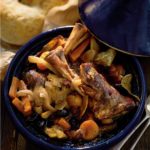Share
“A tagine is a cone-shaped cooking vessel traditionally used in Moroccan cooking,” explains Peter Sanagan, author of the 2021 Shortlisted cookbook, Cooking Meat. ”Meat (commonly lamb, chicken, and beef), vegetables, and liquid are placed in the shallow base, the lid is set on top, and as the food cooks, the steam inside the tagine falls back into the ingredients, creating a delicious combination of flavors. You don’t need a tagine to make this dish—a Dutch oven will do the trick—but the flavor of the broth will be more intense if you do. Tagines are traditionally made from ceramic or unglazed clay and placed directly over a fire, so if you’re using one, cook directly over a gas flame or on a charcoal grill. (The tagine could crack if placed on a heated electric or ceramic-topped element, but to prevent this you can use a heat diffuser, which are widely available to purchase online.) Feel free to double this recipe if your tagine is large enough. Serve with steamed couscous and plenty of flatbread to mop up the delicious juices at the bottom of the pot.”
Follow Peter Sanagan on IG // FB // Twitter
Lamb Shank Tagine
Ingredients
- 1½ tsp harissa paste see note
- 1 Tbsp olive oil
- 3 tsp salt divided
- 2 lamb shanks each about 12 ounces
- 1½ tsp pepper
- ½ tsp ground cumin
- ½ tsp ground coriander
- ¼ tsp ground ginger
- ¼ tsp ground cinnamon
- ½ tsp smoked or regular paprika
- 2 shallots sliced into ¼-inch-thick rings
- 3 garlic cloves chopped
- 1 small carrot quartered lengthwise, and cut in 2-inch lengths
- 1 medium potato peeled and cut in ½-inch wedges 1 celery stalk, cut in 2-inch lengths
- ¼ bulb fennel cut in ½-inch wedges 10 black olives, pitted or whole
- 6 dried apricots
- 1 preserved lemon peel only (see note) 3 bay leaves (dried are fine)
- 2½ –3 cups Chicken Stock divided, see recipe below
Instructions
- In a medium bowl, mix together the harissa, oil, and 1½ tsp of the salt to form a paste. Using your hands, rub the paste all over the shanks, cover, and refrigerate for 6 hours.
- If you don’t have a gas stove, preheat the oven to 350°F. In a small bowl, mix together the remaining 1½ tsp salt, the pepper, cumin, coriander, ginger, cinnamon, and paprika.
- Line the base of your tagine or Dutch oven with the shallots. Sprinkle the garlic over the top, and then place the lamb shanks on top of the shallots, crossing one on top of the other. Sprinkle half of the spice mix over the meat and shallots.
- Arrange the vegetables over the lamb in a pyramid. Sprinkle the vegetables with the rest of the spice mix.
- Scatter the olives, apricots, preserved lemon skin, and bay leaves around the vegetables. Pour 2½ cups of the stock into the base of the tagine or Dutch oven (don’t pour it over the vegetables and meat).
- To cook on a gas stovetop, cover the tagine (or Dutch oven) and place over very low heat. Bring the liquid to a simmer and cook for 2 hours. (If you’re using the oven, cover the Dutch oven with a tight- fitting lid, bring to a simmer over medium heat, then transfer to the oven until the meat is tender, about 2 hours.) After 2 hours, check the tagine. If the liquid has reduced to a sauce consistency, add another ½ cup of stock and cook until the meat pulls away from the bone, about 1 hour.
- Remove the tagine from the heat and allow to cool for 20 minutes. Bring the dish to the table and remove the lid in front of your guests for a “wow” effect.
Notes
Chicken Stock
Ingredients
- 5 pounds chicken bones preferably carcass or back bones
- 5 tsp salt
- 3 onions cut in half widthwise
- 5 garlic cloves
- 4 carrots cut in half
- 3 celery stalks cut in half 1 leek, cut in half
- 6 thyme sprigs
- 5 bay leaves
- 1 Tbsp whole black peppercorns
Instructions
- Preheat the oven to 400°F. Toss the chicken bones with the salt, arrange them in a single layer in a roasting pan, and roast until golden brown, about 30 minutes.
- While the bones are roasting, heat a frying pan over medium-high heat. Add the onions, cut side down, and sear until they’re dark brown. Remove them from the pan and chop.
- Place the roasted bones and onions in a stockpot with the garlic, carrots, onions, celery, leeks, thyme, bay leaves, and peppercorns. Add just enough water to cover the bones and bring to a simmer, uncovered, over medium-high heat. Turn down the heat to low, use a spoon to skim off any scum that’s risen to the top of the stock, and simmer for another 2 hours.
- Remove the stock from the heat and allow to cool for 1 hour before straining through a fine-mesh sieve into a clean container, like a mason jar. Refrigerate for up to 1 week or freeze for up to 3 months.




